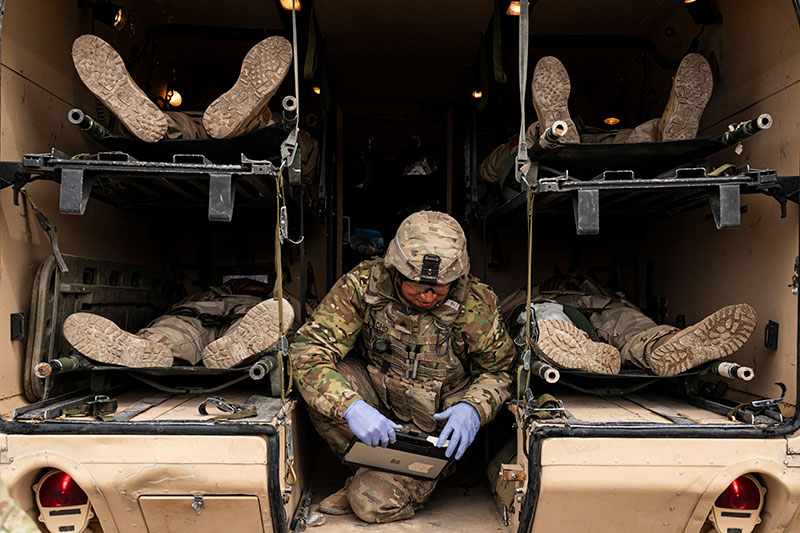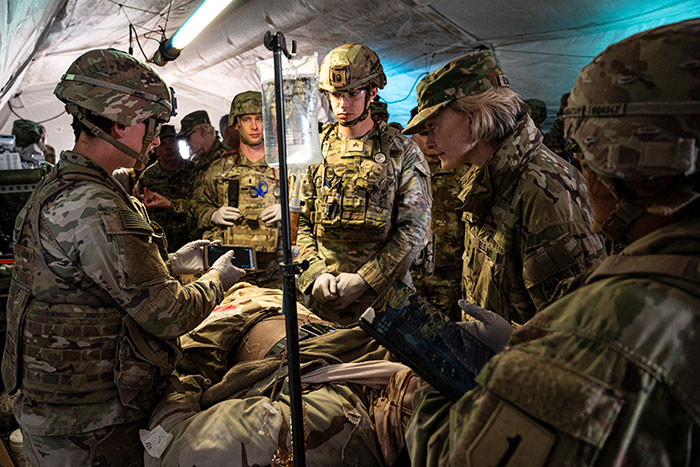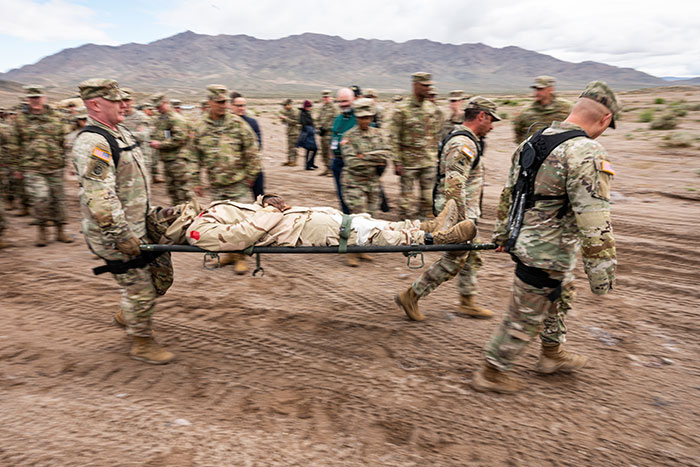Army medical developers put tech capabilities to test during Project Convergence Capstone 4 experiment

Team members with the U.S. Army Medical Materiel Development Activity joined a joint service, multinational contingent this month to test the latest in military medical technology as part of the Army Futures Command Project Convergence Capstone 4 exercise, Fort Irwin, California, March 20, 2024.
USAMMDA participated in PC-C4 to demonstrate the capabilities of the Medical Casualty Predictive Logistics Utilization System (MCPLUS) and the Health Readiness and Performance System (HRAPS) in a real-world, joint service environment at the U.S. Army's National Training Center.
"PC-C4 is an opportunity for the USAMMDA team to demonstrate our technologies in an event that showcases the Army's multi-domain capabilities," said U.S. Army Col. Andy Nuce, USAMMDA's commander. "Our advanced development programs are designed to meet the needs of Warfighters. Getting feedback from prospective end users and partner organizations during experiments like this one helps inform capability requirements and concepts so that USAMMDA can develop and deliver technologies that meet the needs of the future fight."
PC-C4, hosted by the Army at multiple locations, includes participants from all U.S. military services and several invited partner nations. It is designed to test developing concepts for integration of Army forces into a Combined, Joint, All-Domain Command and Control operations framework to ensure force dominance during future conflicts.
Future military operations in austere environments will rely on the capacity of U.S. joint forces and international partners to integrate medical technologies and treatments at each echelon of command. PC-C4 is a proving ground for the materiel under development at USAMMDA, according to Brandon Coburn, senior product management support specialist overseeing the MCPLUS team during the exercise.
MCPLUS is a suite of systems designed to enable rapid and responsive medical logistical support for the joint force using data capture, translation, and treatment analysis from current medical data platforms. It tracks usage of medical supplies and equipment from point of injury through care at a medical treatment facility. Interoperable algorithms for care and treatment (iACT) provide information to improve patient documentation through machine learning. MCPLUS allows predictive logistics and enables near real-time medical inventory management, which will be critical in future operating environments.
"The technologies we're using are designed to provide options for both frontline military medical providers and individual commanders at the tactical level," said Coburn. "Warfighters on future battlefields could be widely dispersed, with our frontline troops far from a large logistics hub and advanced medical care facilities. PC-C4 allows us to collect data and feedback from end users and our leaders, enabling our program office to see how our programs will fit into a complex operational environment, and how we can improve our technologies to enable joint force medical readiness and combat casualty care capacity."
Across the Army, Navy, Air Force, and Marine Corps, modernization efforts– to anticipate future challenges, adapt current capabilities, and develop new strategies – are designed to enable joint forces to fight and win in the austere environments of the Indo-Pacific and Arctic regions of the globe. USAMMDA's continued focus on medical modernization matches the broader efforts of the U.S. Department of Defense.
At PC-C4, Soldiers serving as casualty role players used HRAPS to monitor their physiological parameters during the medical experimentation portion of the exercise. This wearable device is designed to help frontline medical providers and commanders monitor service members' physiological responses to training and combat. Once fielded, HRAPS also may help reduce the risk of non-battle injuries, including heatstroke and overexertion, by providing near real-time data to help leaders recognize serious medical conditions needing immediate treatment before they become critical.
"We are developing the technologies and treatments that will optimize medical triage, enable prolonged care, and inform the return to the fight far-forward in the battlefield," said USAMMDA's Lou Jasper, whose Warfighter Readiness, Performance, and Brain Health Project Management Office oversees HRAPS development. "PC-C4 gives us a snapshot of where our programs are today and how we can refine them to ensure they meet the challenges of large-scale combat operations.

"Our medical capabilities took a huge step forward during operations in Iraq and Afghanistan, where medical facilities and aircraft were more readily accessible due to improvements in evacuation," said Jasper. "However, in future LSCO environments like the Arctic, or island chains found in the Indo-Pacific, evacuation will be contested – requiring advanced medical solutions that can be used far-forward in prolonged care, so that we can most effectively use evacuation assets and extend the ability of combat medics to save lives and rapidly return injured troops to the fight."
USAMMDA is the advanced developer for novel and augmented medical technologies across the joint force. Working with experts and stakeholders in the DoD, government, academia, and industry, USAMMDA leads the development of novel prevention, detection, management, and treatment capabilities, and supports modernization by adapting commercially available technologies to the needs of military medical providers.
"At our level of development, we have a clear idea of joint force requirements," said U.S. Army Master Sgt. Hunter Black, USAMMDA's senior enlisted advisor. "We work with experts across the DoD and industry to focus our efforts and maximize partnerships. But without touchpoints like PC-C4, our teams would not have the Soldier user perspective we need to shape our efforts. These types of events help us to fine-tune our approach, see our products operating in a real-world environment, and get direct feedback from the end user."
USAMMDA is the DoD's premier developer of world-class military medical capabilities. Located at Fort Detrick, Maryland, USAMMDA develops, delivers, and fields critical drugs, vaccines, biologics, devices, and medical support equipment to protect and preserve the lives of Warfighters across the globe.















